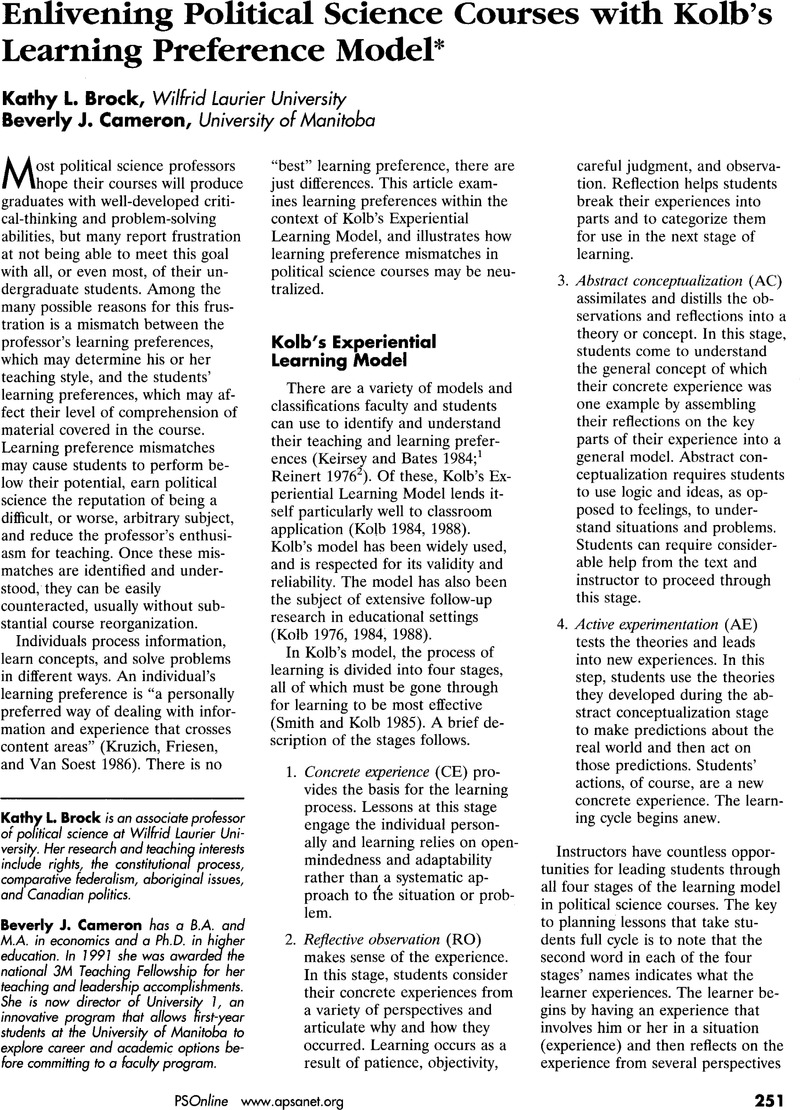Crossref Citations
This article has been cited by the following publications. This list is generated based on data provided by Crossref.
Robinson, Tony
2000.
Service Learning as Justice Advocacy: Can Political Scientists Do Politics?.
PS: Political Science & Politics,
Vol. 33,
Issue. 3,
p.
605.
Box-Steffensmeier, Janet M.
Grant, J. Tobin
Meinke, Scott R.
and
Tomlinson, Andrew R.
2000.
Virtual Field Trips: Bringing College Students and Policymakers Together through Interactive Technology.
PS: Political Science & Politics,
Vol. 33,
Issue. 04,
p.
829.
Morgan, William
and
Streb, Matthew
2002.
Promoting Civic Activism: Student Leadership in Service‐Learning.
Politics & Policy,
Vol. 30,
Issue. 1,
p.
161.
Damron, Danny
and
Mott, Jonathan
2005.
Creating an Interactive Classroom: Enhancing Student Engagement and Learning in Political Science Courses.
Journal of Political Science Education,
Vol. 1,
Issue. 3,
p.
367.
Lay, J. Celeste
and
Smarick, Kathleen J.
2006.
Simulating a Senate Office: The Impact on Student Knowledge and Attitudes.
Journal of Political Science Education,
Vol. 2,
Issue. 2,
p.
131.
KRAIN, MATTHEW
and
LANTIS, JEFFREY S.
2006.
Building Knowledge? Evaluating the Effectiveness of the Global Problems Summit Simulation.
International Studies Perspectives,
Vol. 7,
Issue. 4,
p.
395.
Baranowski, Michael
2006.
Single Session Simulations: The Effectiveness of Short Congressional Simulations in Introductory American Government Classes.
Journal of Political Science Education,
Vol. 2,
Issue. 1,
p.
33.
Shellman, Stephen M.
and
Turan, Kürşad
2006.
Do Simulations Enhance Student Learning? An Empirical Evaluation of an IR Simulation.
Journal of Political Science Education,
Vol. 2,
Issue. 1,
p.
19.
Pappas, Christine
2007.
“You Hafta Push”: Using Sapphire's Novel to Teach Introduction to American Government.
Journal of Political Science Education,
Vol. 3,
Issue. 1,
p.
39.
Westlake, E. J.
2007.
Finding the Time Capsule: Enabling Undergraduates in Theatre Studies Classrooms to Know what They Know.
Youth Theatre Journal,
Vol. 21,
Issue. 1,
p.
138.
Kiasatpour, Soleiman
and
Whitfield, Christopher
2008.
Politics in Action: Wolves, Snowmobiles, and Bison and
the Greater Yellowstone Ecosystem.
PS: Political Science &
Politics,
Vol. 41,
Issue. 1,
p.
193.
Georgiou, I.
Zahn, C.
and
Meira, B. J.
2008.
A systemic framework for case‐based classroom experiential learning.
Systems Research and Behavioral Science,
Vol. 25,
Issue. 6,
p.
807.
Kelle, Alexander
2008.
Experiential Learning in an Arms Control
Simulation.
PS: Political Science &
Politics,
Vol. 41,
Issue. 2,
p.
379.
Powner, Leanne C.
and
Allendoerfer, Michelle G.
2008.
Evaluating Hypotheses about Active Learning.
International Studies Perspectives,
Vol. 9,
Issue. 1,
p.
75.
Ripley, Brian
Carter, Neal
and
Grove, Andrea K.
2009.
League of Our Own: Creating a Model United Nations Scrimmage Conference.
Journal of Political Science Education,
Vol. 5,
Issue. 1,
p.
55.
Baranowski, Michael
and
Weir, Kimberly
2010.
Power and Politics in the Classroom: The Effect of Student Roles in Simulations.
Journal of Political Science Education,
Vol. 6,
Issue. 3,
p.
217.
Moore, Matthew J.
2011.
How (and What) Political Theorists Teach: Results of a National Survey.
Journal of Political Science Education,
Vol. 7,
Issue. 1,
p.
95.
Glazier, Rebecca A.
2011.
Running Simulations without Ruining Your Life: Simple Ways to Incorporate Active Learning into Your Teaching.
Journal of Political Science Education,
Vol. 7,
Issue. 4,
p.
375.
Coffey, Daniel J.
Miller, William J.
and
Feuerstein, Derek
2011.
Classroom as Reality: Demonstrating Campaign Effects Through Live Simulation.
Journal of Political Science Education,
Vol. 7,
Issue. 1,
p.
14.
Doherty, David
2011.
Teaching Experimental Methods: A Framework for Hands-On Modules.
Journal of Political Science Education,
Vol. 7,
Issue. 2,
p.
163.





